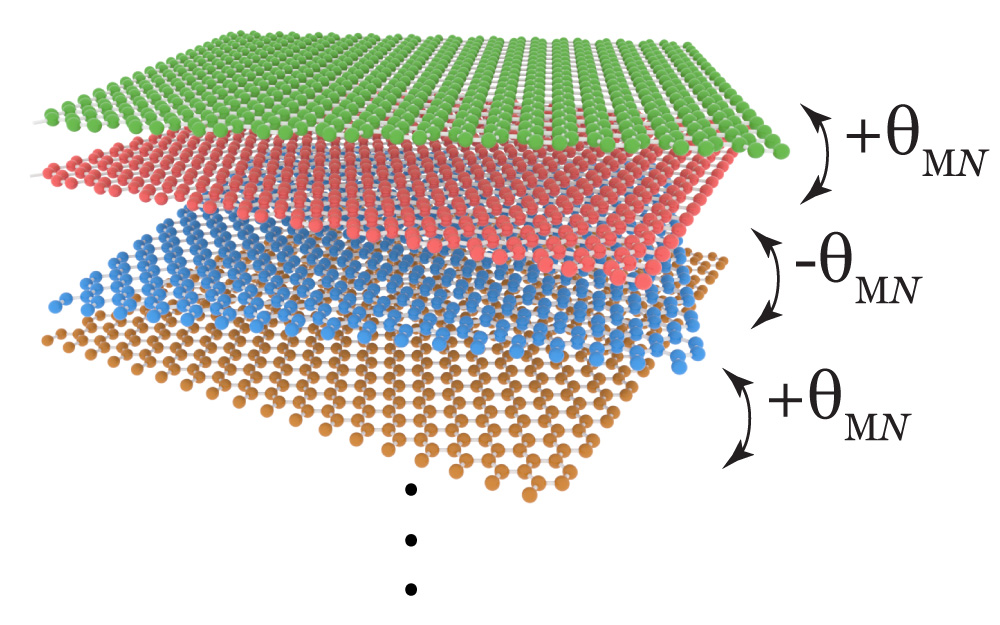Superconducting graphene is at the forefront of revolutionary research in materials science, particularly due to its unique properties that enhance lossless power transmission and quantum computing capabilities. This groundbreaking study delves into the behavior of superfluid electrons within twisted graphene structures, which have shown promise in enabling energy-efficient detectors and advancing technologies like levitating trains. Researchers from elite institutions such as Harvard and MIT have identified how the twisting of graphene layers creates superconducting states that differ significantly from traditional superconductors. Such discoveries not only deepen our understanding of superconductivity but also open avenues for harnessing these materials in practical applications. As scientists map the quantum dances of these paired electrons, the potential for transformative impacts on our future technologies grows exponentially.
Graphene with superconducting properties represents a cutting-edge area of exploration that combines innovative material design with the principles of quantum mechanics. When layers of this one-atom-thick carbon material are slightly twisted, they exhibit unusual electrical characteristics that can be harnessed for various high-tech applications, from energy transfer without losses to ultra-sensitive detection capabilities. The phenomenon of swirling electrons, resembling a superfluid state, allows for advanced functionalities in computing and transportation technologies. Research teams are excited about the implications of such materials, especially concerning their use in creating efficient solutions for modern challenges. The intersection of twisted graphene and superconductivity stands as a testament to the ongoing quest for breakthroughs in the realm of condensed matter physics.
Understanding the Mechanics of Superconducting Graphene
Superconducting graphene, particularly in its twisted form, represents a revolutionary advancement in materials science. By inducing a slight twist in graphene layers, researchers have uncovered unique superconducting properties that diverge notably from traditional superconductors. These properties arise because the electrons in twisted graphene interact uniquely, leading to the formation of a superfluid state. This phenomenon allows electrons to glide through the material without resistance, enhancing the potential for applications in quantum computing and lossless power transmission.
The understanding of superconducting graphene is still being developed. Scientists are investigating how these superfluid electrons pair and behave under low temperatures, aiming to decode the mechanics behind their quantum dance. Researchers are utilizing innovative techniques, such as microwave resonant circuits to observe the vibrational modes of superconducting electrons. These studies not only offer insights into the superconducting phenomena of twisted graphene but also have the potential to inform studies on other complex superconductors.
Applications of Twisted Graphene in Quantum Technologies
Twisted graphene holds immense potential for transforming quantum technologies, particularly in the realm of quantum computing. With its ability to maintain superconductivity at higher temperatures compared to traditional materials, it paves the way for more accessible quantum computing platforms. The interactions between the superfluid electrons create a stable environment for qubits, which could enhance the performance and efficiency of quantum computers. This innovation would further accelerate the development of next-generation computational technologies.
Moreover, the unique properties of twisted graphene extend beyond quantum computing. The material’s potential for lossless power transmission could revolutionize electrical grids, leading to more efficient energy systems. This is particularly essential as the demand for sustainable energy solutions continues to rise. Additionally, the development of energy-efficient detectors utilizing twisted graphene is a promising avenue for advancements in space exploration, where the need for delicate yet powerful instrumentation is critical.
The Role of Superfluid Electrons in Advanced Physics
Superfluid electrons within twisted graphene exhibit remarkable characteristics that challenge our conventional understandings of physics. When electrons pair up, they transition into a superfluid state, allowing them to conduct electricity without energy loss. This phenomenon is not only significant for technological applications but also presents intriguing questions about the fundamental principles of quantum mechanics. Understanding the unique interactions between these electrons can unveil new pathways for research in complex materials and superconductivity.
Additionally, the study of superfluid electrons has broader implications for the complexity of electron behavior in various materials. The directional adhesive forces that have been observed, similar to those in high-temperature superconductors, could provide insights into electron pairing in other unconventional superconductors. By continuing to explore this quantum behavior, researchers hope not only to elucidate the unique properties of superconducting graphene but also to contribute to the foundational theories that govern electron interactions in broader contexts.
Advantages of Energy-efficient Detectors in Space Exploration
The advancement of energy-efficient detectors is crucial for future space exploration missions, where operational resources are often minimal. With the development of detectors based on twisted graphene, scientists can achieve ultra-sensitive performance in detecting faint signals in the near vacuum of space. These innovations would allow space instruments to operate on lower power, making them more sustainable and effective for long-duration missions.
In addition to power efficiency, the resolutions offered by these detectors can significantly impact scientific discoveries. With the ability to capture fine details in a low-light environment, twisted graphene detectors can enhance our understanding of cosmic phenomena and facilitate groundbreaking research in astrophysics. As this technology matures, it has the potential to unlock new frontiers in our comprehension of the universe.
Twisted Graphene and the Future of Lossless Power Transmission
The potential for twisted graphene to play a role in lossless power transmission cannot be overstated. Unlike conventional materials that dissipate energy as heat, superconducting graphene allows for the seamless transfer of electrical energy. This characteristic could lead to the creation of electrical grids that eliminate energy losses, significantly enhancing efficiency and sustainability. As global energy demands increase, developing such technologies becomes essential.
The transition to superconducting graphene in power transmission systems may also drive innovation in transportation technology. For example, magnetic levitation trains operating on superconducting principles could revolutionize the way we travel, offering faster and more energy-efficient alternatives to traditional rail systems. This intersection of superconductivity and transportation holds great promise for shaping future infrastructure.
Innovative Techniques in Researching Twisted Graphene
Researching the unique properties of twisted graphene demands innovative techniques, particularly in how scientists probe the behavior of its superconducting electrons. Microwave resonance techniques have emerged as a key method for studying the vibrational characteristics of superfluid electrons. By creating a resonant circuit mimicking a glass harp, researchers can effectively ‘listen’ to the superconducting state, gaining insights into the pairing mechanisms and behaviors of electrons in this new class of materials.
Additionally, these experimental approaches not only illuminate the specific properties of twisted graphene but also pave the path for exploring other materials exhibiting superconductivity. The directionality of the adhesive forces observed at play provides a comparative framework for studying other unconventional superconductors. The continuous development of such probing techniques is crucial for advancing the scientific understanding of quantum materials and their potential applications.
Comparative Studies: Traditional Superconductors vs. Twisted Graphene
Comparative studies between traditional superconductors and twisted graphene reveal significant differences in electron behavior and superconducting capabilities. Traditional superconductors, like aluminum, tend to exhibit superconductivity at very low temperatures and have specific electron pairing mechanisms. In contrast, twisted graphene showcases a more complex intertwining of quantum mechanics and electron interactions, allowing for superconductivity at higher temperatures and introducing new possibilities in electron pairing dynamics.
These insights emphasize why twisted graphene is gaining attention in the field of condensed matter physics. The differences in superconducting behavior highlight the need for further research into twisted structures and their potential applications. As scientists continue to compare these materials, it becomes increasingly clear that twisted graphene could lead to significant advancements in various technological spheres, from energy transmission to quantum computing.
Exploring the Quantum Dance of Electrons in Twisted Graphene
The term ‘quantum dance’ coined by researchers captures the intricate movements of electrons in twisted graphene layers. As these electrons synchronize their motions at cryogenic temperatures, they exhibit fascinating behaviors typical of superconductors, including zero electrical resistance. Investigating how these electrons interact provides essential clues about the fundamental processes that govern superconductivity and may lead to breakthroughs in material science.
In practical terms, understanding this quantum dance could lead to enhanced control over the behavior of superfluid electrons in applications ranging from quantum computing to energy-efficient technologies. As the layers of twisted graphene interact, the resultant properties can be harnessed in designing better superconducting materials, potentially revolutionizing industries reliant on superconductivity.
The Potential of Twisted Graphene in High-temperature Superconductivity Research
Twisted graphene may hold the key to advancements in high-temperature superconductivity research, a field that has long captivated scientists. Understanding the superconducting mechanisms in twisted graphene can shed light on the behaviors observed in high-temperature superconductors, where electron pairing remains a mystery. The insights gained could catalyze the discovery of new materials that operate effectively at higher temperatures, crucial for practical applications.
Additionally, the directional nature of the adhesive forces observed in twisted graphene parallels phenomena found in other complex superconductors. This connection implies that the research conducted on twisted graphene could influence broader studies in superconductivity, potentially leading to innovative solutions to pressing energy challenges. As researchers delve deeper into this promising material, it may ultimately contribute to a new era of high-temperature superconductors.
Frequently Asked Questions
What is superconducting graphene and how does it differ from traditional superconductors?
Superconducting graphene refers to the superconductivity observed in twisted stacks of graphene layers. Unlike traditional superconductors like aluminum, superconducting graphene exhibits unique behaviors at low temperatures, such as electron pairing that occurs through a ‘glue’ interaction influenced by quantum mechanics. This results in superfluid electrons that flow without energy loss, a property that conventional superconductors do not fully display.
How does twisted graphene enhance lossless power transmission?
Twisted graphene enhances lossless power transmission due to its superconducting properties. The unique electron pairing and subsequent superfluid formation in twisted graphene allow for electricity to be transmitted without resistance, leading to improved efficiency in power systems compared to traditional conductors.
What potential applications do superconducting graphene have in quantum computing?
Superconducting graphene holds significant promise for quantum computing due to its ability to create qubits that are less susceptible to decoherence. The intrinsic low-energy loss characteristics and efficient electron pairing can lead to more stable and faster quantum computations, making superconducting graphene a valuable material in next-generation quantum processors.
Can superconducting graphene be used in energy-efficient detectors?
Yes, superconducting graphene can be utilized in energy-efficient detectors. Researchers are exploring its potential for building ultrasensitive detectors that require minimal power while maintaining high resolution, particularly useful for applications in space exploration, where light levels are low.
What are the benefits of superfluid electrons in superconducting graphene systems?
The benefits of superfluid electrons in superconducting graphene systems include the ability to flow without energy loss, leading to greater efficiency in electronic devices. This phenomenon allows for advanced applications like lossless power transmission and enhanced capabilities in technologies such as quantum computing.
What is the significance of studying electron pairing in twisted graphene?
Studying electron pairing in twisted graphene is significant because it may unveil the mechanisms behind superconductivity in two-dimensional materials. Understanding this ‘quantum dance’ of electrons can provide insights not only into twisted graphene but also into other high-temperature superconductors, potentially unlocking new applications and technologies.
| Key Points |
|---|
| Superconductors transmit electricity without resistance, first discovered in 1911. |
| Twisted graphene, when stacked, exhibits unique superconducting behavior. |
| Research from Harvard and MIT uncovered new interactions among electrons in twisted graphene. |
| Understanding these electron pairs could lead to advancements in power transmission and quantum computing. |
| Potential applications include energy-efficient detectors for space exploration. |
Summary
Superconducting graphene represents a groundbreaking advancement in material science, showcasing the ability to conduct electricity with zero resistance. This innovative form of graphene, particularly when twisted, has revealed new superconducting properties that differ significantly from traditional superconductors. As researchers delve into the unique electron interactions within twisted graphene, they unlock future applications ranging from efficient power transmission to revolutionary developments in quantum computing and space technology.




